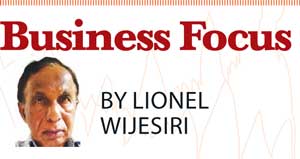28 Nov 2016 - {{hitsCtrl.values.hits}}

 If there is one trend that has demonstrated a company’s staying power over the past two decades, it is the movement of renewal strategy formulation out of corporate hierarchy and into business units. The reason is as obvious as it is sensible: business units are nearer to the famed three Cs - customers, competitors and costs.
If there is one trend that has demonstrated a company’s staying power over the past two decades, it is the movement of renewal strategy formulation out of corporate hierarchy and into business units. The reason is as obvious as it is sensible: business units are nearer to the famed three Cs - customers, competitors and costs.
If hierarchy sees the marketplace from 20,000 feet, then the business unit’s managers see it from 2,000 feet—or from 200 if they’re smart. This bird’s-eye view allows them to get a keener look at opportunity ahead, trouble alongside and danger from below.
Best of all, like a bird in flight, a business unit can manoeuvre with more agility than a 300-ton airplane. No wonder it’s getting hard to find companies that still try to make strategy from on high.
Strategic focus
But just as hierarchy did in the ‘old days’, business units can lose strategic focus. Considering that business units today have the capacity to be highly attuned to the marketplace why does that happen? Business analysts believe that business units, like people, reach and surpass their potential - when managers rivet their attention to what the company does best.
In the past two and half months, we have analysed briefly 10 renewal strategies. To determine which renewal strategy is most appropriate, analyse why your business is no longer connecting to the market as it once was. It won’t help you to renew your customer base if you have the wrong assets to serve them and there’s no point in optimizing your asset base if your real problem is a lack of connection to a paying customer base.
Companies whose businesses are underperforming often become introspective and focused on cost cutting in an effort to realize the accompanying efficiencies. However, it’s at this time that the leaders need to look externally. You can deliver products and services with all the care and quality in the world but if nobody wants to buy your products, the business dies.
There wasn’t anything wrong with the VCR equipment companies were making 15 years ago. The problem is that their old customers now are recording shows in digital format and storing them on hard drives. The customers have moved on and they are not coming back.
There may still be plenty of consumers who want your product but you might no longer deliver it in a form they want.
Outdated process
Look at the older rest houses in our country. Sure, you could stay few days at one of these older places. But most people don’t want to because these places are no longer as compelling as the newer, larger hotels. Their assets have become so outdated they are worth more as a hole in the ground for future development than they are worth as ongoing businesses.
Or consider the future of printed Yellow Pages. Boomers may love it but Gen-Y sees no use for it. Younger consumers still need access to the knowledge contained in the Yellow Pages but they are meeting these needs online and through their cell phones. Sometimes we complain that customers are a fickle lot but the truth of the matter is that they want what they want.
Spend some time thinking about the opportunities presented by your customer relationships and the assets at your disposal. Then consider each of the 10 strategies as a possible answer for your business. You’ll find many of the answers don’t fit you they just don’t feel right. But others will make more sense.
In the next few weeks we will provide an overview of the process of renewal. Subsequently, we will explain the tools and techniques that will lead you up to your own, real-world solutions.
Twin objectives
The leader of every renewal effort has two objectives. First, to identify a great strategy that adds real value and promise for the future; second, to align the company behind that strategy and obtain the commitment necessary to make it happen.
These twin objectives are not always met. Why is it difficult to identify a great strategy that will add significant value to your company? We see four reasons.
1. Your people are already overloaded just to run your business. Who will do the work required for renewal and how will they free up their time to get it done?
2. The world is a complex place and nothing about the future is certain. Because of this, you will never be able to prove conclusively which renewal alternative is the best. Your renewal choice requires judgment and it is your judgment that will be tested.
3. Your renewal objectives may he unclear. If you don’t know what you are trying to maximize and what you are willing to trade off, it will be impossible to find an optimum solution. Without a defined set of objectives, renewal efforts tend to wander and are slow to reach closure.
4. An alternative may meet some objectives and do poorly on others. So when choosing a strategy you must eventually face trade-offs between the things you want. These are never easy.
Agreement
Without a great strategy, people will be unwilling to commit to a plan that appears to them to be unlikely to succeed or that appears to have limited value even if it does succeed.
Assuming you have developed a great strategy, what stands in the way of getting your colleagues to agree on it and commit to it? First, players may have different objectives, priorities, beliefs and constraints. A particular action may be important for one part of the company but may be a low priority for others. You need to work cross-functionally across team and business lines to successfully renew a business. And you must do so knowing that not everyone wants the same thing or sees things in the same way.
Second, some executives may be focused on organisational issues, power and politics rather than value creation. Though everyone talks about value, many managers optimize their part of the company at the expense of the whole.
Third, intelligent, well-intentioned people may disagree as to the best course of action. While some may have decided on what they believe to be the best strategy, others may disagree and be hesitant to commit. Others may focus strongly on a different path.
Without agreement, well-intentioned people will pull the company in different directions. Without commitment to action, nothing will happen. The talk may be there but the action will not be.
To overcome these hurdles, you need an effective and efficient renewal process to guide your efforts and the dialogue between the decision-makers and the workers. We will cover both the process and the dialogue in the next article. For today, we will get an idea about the phases of renewal.
Phases of renewal
The process of renewal is quite straightforward and orderly. But because renewal is not a natural event in most companies, we have designed a process to guide companies possessing limited renewal experience.
There are three phases in the renewal process: rethink, reinvent and reposition.
Rethink is deciding which businesses need renewal and which should continue operations as usual. Reinvent is the creation of the new business model that will provide an attractive future for the business. Reposition is the action of transitioning from the old business model to the new one.
Each of the three phases is separated by a resource allocation decision. Between rethink and reinvent you must decide whether or not you are going to commit the company to a renewal effort. And between reinvent and reposition you must choose the best renewal alternative for your company.
(Lionel Wijesiri is a retired corporate director counting three decades of senior management experience. He is now an independent consultant and a freelance journalist. He may be contacted on [email protected])
10 Jan 2025 5 minute ago
10 Jan 2025 12 minute ago
10 Jan 2025 28 minute ago
10 Jan 2025 43 minute ago
10 Jan 2025 48 minute ago